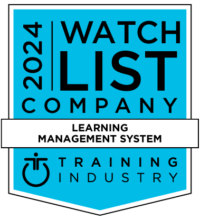Keeping up with workplace safety training is critically important for protecting your employees from harm and your company from the financial and legal implications of accidents.
Each year, workplace accidents cost U.S. companies $62 billion, including an estimated $1 billion weekly in direct workers’ compensation payouts alone.
But now, the stakes are even higher as the COVID pandemic has changed everything about how we work. Companies that never had to think about public health as a part of their operations now must diligently train employees in the proper use of PPE and infectious disease control. And, with the number of COVID-related lawsuits mounting, companies simply cannot afford any room for error in their safety programs. Complicating matters, safety guidelines and best practices are changing frequently as we learn more about COVID and how it spreads, forcing companies to constantly adjust their protocols and training programs.
Aside from adding COVID-related content to the curriculum, the way we train is also shifting dramatically. With some 42% of the labor force now working from home—many while also caring for children and doubling as home school teachers—the sheer logistics of training are now much more complex. Employees are stressed, pressed for time and their schedules are unpredictable.
As a result, companies must adapt the way they create, manage and deliver safety training in order to provide effective content, maintain compliance and protect employees and the company from harm—physical or financial.
7 Tips for Adapting Your Safety Training Program During and Post COVID-19
1. Keep up with changing protocols. As the science around COVID-19 evolves, safe operating guidelines change frequently with new guidance issued on a weekly or even daily basis. Make it a habit to check daily for updated recommendations or requirements at the CDC’s Guidance Page, OSHA “What’s New” page, the Federal Motor Carrier Safety Administration and other regulatory bodies governing your business. Sign up for automated email alerts that deliver new guidance straight to your inbox to stay current with the newest requirements
2. Re-evaluate your build vs. buy decision. Because changes are happening so quickly, it can be hard to keep your training curriculum up to date. Does your organization have the time, staff and resources to revise and deploy new materials at the cadence required? If not, now is a good time to consider using a training content provider with the dedicated resources to keep pace with updates and the scale to deploy new content rapidly. Keep in mind that pre-built content can always be customized to your industry or company, so you’re never boxed-in to off-the-shelf training that doesn’t quite fit your needs.
3. Shift your delivery methods. With physical distancing requirements, travel and indoor gatherings discouraged, the days of face-to-face training are gone—possibly forever now that we’ve proven the power of remote work. That means virtual training is obviously a must, but because things are changing so quickly, it can’t be a one-and-done situation. Training programs must be ongoing, available in real-time, on demand and across multiple devices to give employees the access they need, when they need it.
This allows work-from-home employees and in-the-field workers to complete the required curriculum any time, on their own schedule. For example, truck drivers can train during a break with an iPad or field technicians can catch up on new standards during lunchtime on their mobile phone. Shifting to on-demand training ensures the latest updates are implemented and employees can train on a schedule that fits their situation.
4. Strengthen your measurement standards. It used to be enough to provide proof of training in the event of a lawsuit, but many states now mandate routine training in sexual harassment prevention and diversity, for example, which makes detailed standards a must for compliance. Beyond just checking the box of completion, shift toward gauging understanding of the material to make sure employees understand “the why” behind policies and the risks for noncompliance.
Implementing engagement metrics can help you track trainee understanding and provide feedback to help you revise content for continuous improvement. Measuring things like time spent on specific modules, activity completion rates, total time to completion and drop-off points can help you identify content that’s too difficult, too easy or just too boring. Use surveys to gather employee feedback to learn what’s working and what’s not. And of course, tracking on-the-job performance—behavior compliance, incident rates, etc.—can also help improve training quality and ensure employees aren’t just mindlessly clicking through slides or starting a video to play and walking away.
5. Implement real-time compliance tracking. Aside from being a must-have to protect your company from a legal standpoint, many industries are also mandated to provide proof of training to a regulatory body. But, trying to keep track of who has completed what training with spreadsheets is entirely insufficient to keep pace with today’s rapidly changing landscape.
Instead, implement a real-time compliance solution that automatically sends proof of completion to designated managers and allows you to instantly provide verification of an employees’ entire training history. A compliance tracking solution not only makes it easier to produce the necessary documentation but also helps keep your compliance program up to date. The best platforms keep track of upcoming re-certifications, licensing and refresher needs and send automatic alerts to employees and training managers about upcoming expirations and renewals. This kind of automated solution saves your team time and hassle and provides peace of mind.
6. Remember there’s a human involved. The whole point of safety training is to protect your employees from harm, but it’s easy to get caught up in the logistics of training and forget the human element. Especially now, with the pandemic, social unrest, economic concerns and more, your employees are under a lot of stress. Many are dealing with their own fears and health concerns or worried about protecting their family. Some may even be the sole breadwinner in their household due to job loss, while also serving as a caregiver to children and/or aging parents.
It’s a lot to handle all at once. That’s why you must take employee mindset and societal context into consideration when designing and deploying training. Remember that your employees are facing a lot of adversity right now and use curricula and deployment methods that are sensitive to the human element to reassure your staff and help mitigate their stress level.
7. Don’t neglect the rest of your training. Of course, COVID is top of mind right now, but be careful not to overlook or get behind in other critical trainings such as security procedures, conflict resolution, DOT compliance, and workplace conduct and harassment training to keep your workers and your company protected. Cybersecurity training should also be a top priority—work from home employees are especially vulnerable to hacking and we’ve already seen a huge spike in COVID-related cyberattacks.
Now is also a great time to help furloughed employees brush up on their training and keep their certifications current so they can hit the ground running when business picks up. A learning management system (LMS) can keep your company up to date on real-time needs and deliver the required materials to employees wherever and whenever they need them.
As we adapt to COVID and a post-COVID workplace, we need to think holistically about how we create, implement, track and communicate training. With face-to-face training off the table, companies must deploy virtual programs to keep their employees safe and their company compliant. Implementing these strategies—along with the right tools for real-time, safety training, HR and regulatory compliance—can help your company adhere to changing regulations and keep your training program on track.
This article was originally published on TrainingIndustry.com in September 2020.







